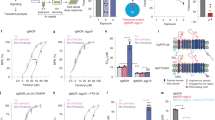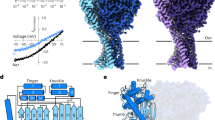Abstract
A characteristic feature of induced pinocytosis in Amoeba proteus is the formation of broad channels by invagination of the cell membrane. This process, which requires Ca2+, occurs in response to depolarising cations1–4. High Ca2+ levels reduce pinocytosis induced by cations such as Na+ and Tris+, whereas pinocytosis induced by K+ is less affected by Ca2+ (ref. 4). Agents which interfere with the calcium metabolism of the amoeba will therefore either stimulate or inhibit pinocytosis induced by Na+ (ref. 5). Among the agents which are supposed to reduce Ca2+ influx across cell membranes or otherwise decrease cellular availability of Ca2+ are the opiates and opioid peptides6–9, high doses of which have been reported to affect the amoeba10. Accordingly, Met-enkephalin, morphine and codeine potentiate the inhibition of pinocytosis caused by Ca2+-binding agents and reverse the calcium blockade of pinocytosis mediated by caffeine11. In this report we show that pinocytosis induced by Na+ or Tris+ is suppressed by β-endorphin, Metenkephalin and morphine. These effects were abolished or diminished by an opiate receptor antagonist, (–)naloxone, by increasing the Na+ concentration, or by addition of Ca2+.
This is a preview of subscription content, access via your institution
Access options
Subscribe to this journal
Receive 51 print issues and online access
$199.00 per year
only $3.90 per issue
Buy this article
- Purchase on Springer Link
- Instant access to full article PDF
Prices may be subject to local taxes which are calculated during checkout
Similar content being viewed by others
References
Chapman-Andresen, C. C.r. Trav. Lab. Carlsberg 33, 73–264 (1962); in The Biology of Amoeba (ed. Jeon, K. W.) 319–348 (Academic, New York, 1973).
Brandt, P. W. & Freeman, A. R. Science 155, 582–585 (1967).
Josefsson, J.-O. Acta physiol. scand. Suppl. 432, 1–65 (1976); Acta physiol. scand. 73, 481–490 (1968).
Josefsson, J.-O. & Hansson, S. E. Acta physiol. scand. 96, 443–455 (1976).
Johansson, P. & Josefsson, J.-O. Acta physiol scand. 102, 71A–72A (1978).
Harris, R. A., Loh, H. H. & Way, E. L. J. Pharmac. exp. Ther. 195, 448–498 (1975).
Yamamoto, H., Harris, R. A., Loh, H. H. & Way, E. L. Life Sci. 20, 1533–1540 (1977); J. Pharmac. exp. Ther. 205, 255–264 (1978).
Guerrero-Munoz, F., Guerrero, M. L., Leong Way, E. & 7th Int. Congr. Pharmac. Abstr. 440 (Pergamon, Paris, 1978).
Leong Way, E., Harris, R. A. & Loh, H. H. in Factors Affecting the Action of Narcotics (eds Adler, M. L., Manara, L. & Samanin, R.) 413–422 (Raven, New York, 1978).
Zimmerman, A. M. J. Protozool. 14, 451–455 (1967).
Josefsson, J.-O. & Johansson, P. 7th Int. Congr. Pharmac. Abstr. 543 (Pergamon, Paris, 1978).
Chapman-Andresen, C. C.r. Trav. Lab. Carlsberg 31, 77–92 (1958).
Prescott, D. M. & James, T. W. Expl Cell Res. 8, 256–258 (1955).
Josefsson, J.-O. & Hansson, S. E. Acta physiol. scand. 95, 270–285 (1975).
Iijima, I., Minamikawa, J., Jacobson, A. E., Brossi, A. & Rice, K. C. J. med. Chem. 21, 398–400 (1978).
Singh, B. N., Ellrodt, G. & Peter, C. T. Drugs 15, 169–197 (1978).
Pert, C. B. & Snyder, S. H. Molec. Pharmac. 10, 868–879 (1974).
Simon, E. J., Hiller, J. M., Groth, J. & Edelman, I. J. Pharmac. exp. Ther. 192, 531–537 (1975).
Jhang, J.-K., Fong, B. T. W., Pert, A. & Pert, C. B. Life Sci. 18, 1473–1482 (1976).
Kaku, T., Kaneto, H. & Koida, M. Jap. J. Pharmac. 24, Suppl. 123 (1974).
Author information
Authors and Affiliations
Rights and permissions
About this article
Cite this article
Josefsson, JO., Johansson, P. Naloxone-reversible effect of opioids on pinocytosis in Amoeba proteus. Nature 282, 78–80 (1979). https://doi.org/10.1038/282078a0
Received:
Accepted:
Issue Date:
DOI: https://doi.org/10.1038/282078a0
This article is cited by
-
How can drug addiction help us understand obesity?
Nature Neuroscience (2005)
-
Immunocytochemical verification of the insulin receptor's specificity in the nuclear envelope of Tetrahymena. Comparison with receptors of the plasma membrane
Bioscience Reports (1994)
-
The binding of diazepam in the mitochondria of Tetrahymena pyriformis as detected by quantitative high resolution autoradiography
Bioscience Reports (1993)
-
TheE. coli EnvY gene encodes a high affinity opioid binding site
Neurochemical Research (1993)
-
Insulin antagonizes the phagocytosis stimulating action of histamine in Tetrahymena
Bioscience Reports (1992)
Comments
By submitting a comment you agree to abide by our Terms and Community Guidelines. If you find something abusive or that does not comply with our terms or guidelines please flag it as inappropriate.



